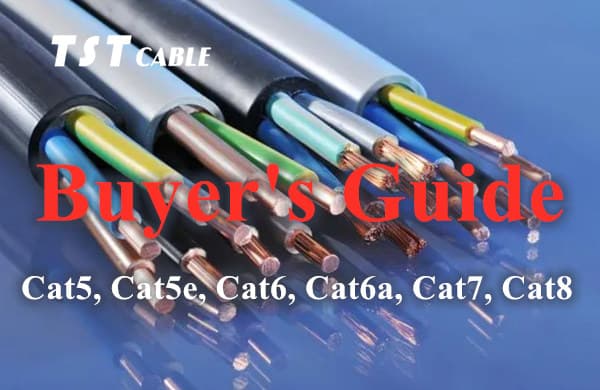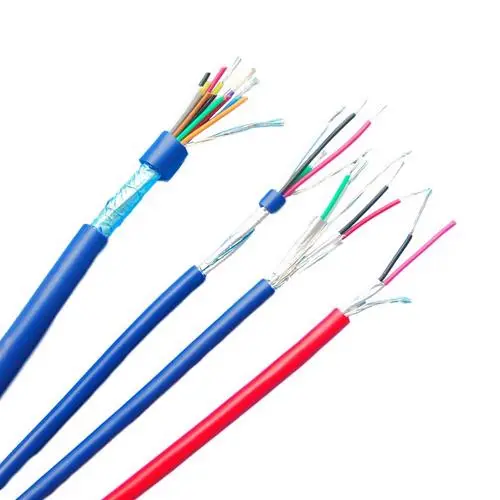Cat5/5e, Cat6/6a, Cat7, and Cat8 cables differ significantly in several ways, and these differences are mainly in transmission rates, frequencies, construction, and application scenarios.
Below is TST CABLES’ detailed comparison and buying guide for these cables:

Cat5 and Cat5e cables:
Cat5 cables were an earlier type of networking cable that supported frequencies up to 100MHz, but have been gradually replaced by Cat5e due to its performance limitations.
Cat5e cable (Ultra Category 5) is an upgraded version of Cat5, which also supports frequencies up to 100MHz, but with much better performance and support for Gigabit Ethernet (where desirable.) Cat5e cable is flexible and suitable for tight spaces such as residential areas, but can also be used in commercial spaces.
Cat6 and Cat6a cables:
Cat6 cable (Category 6) offers a significant increase in performance, supporting frequencies up to 250 MHz and enabling transmission rates of up to 1 Gbps over distances of up to 100 m. Cat6 cable also features improved crosstalk protection for network environments that require higher bandwidth.
Cat6a cable (Category 6 A cable) is an enhanced version of Cat6 that supports frequencies up to 500MHz and also achieves maximum transmission speeds of up to 10Gbps.Cat6a cable is suitable for Gigabit networking applications that require faster speeds and higher bandwidth.
Cat7 Cable:
Cat7 cable (Category 7) can transmit at least 600 MHz and at speeds up to 10 Gbps. it is designed primarily for the application and development of 10 Gigabit Ethernet technology for network environments that require extremely high speeds and bandwidths.
Cat8 Cable:
Cat8 cable is the latest generation of networking cable that supports speeds up to 25Gbps and even 40Gbps. It is similar in physical appearance to lower category cables, but can terminate in either an RJ45 connection or a non-RJ45 connection.Cat8 cable is backward compatible with its previous versions, allowing for a high degree of flexibility when upgrading your network.

Cat5 vs. Cat5e vs. Cat6 vs. Cat6a vs. Cat7 vs. Cat8: What Are Their Differences?
- Speed: The ethernet cable speed of transmission changes according to the Ethernet cable categories, which determines the effectiveness of the cable.
- Bandwidth: Normally, if a cable has a higher frequency of MHz, the transmission speed is more efficient.
- Shielding: Cable shielding is a layer of material that is wrapped around the wires inside a cable to reduce interference and improve signal quality.
- Crosstalk: The “bleeding” of signals between one cable into another due to “induction” will result in slow network transfer speeds, and even block the transfer of signals over the cable.
The performance of these different Ethernet cable categories from Cat5 to Cat8 is as follows:
| Category | Transmission Speed | Transmission Distance | Bandwidth | Shielding Type | Application |
|---|---|---|---|---|---|
| Cat5 | 100Mbps | 100m (328ft.) | 100MHz | Unshielded | 100BaseT Ethernet |
| Cat5e | 1Gbps | 100m (328ft.) | 100MHz | Shield/Unshield | Gigabit Ethernet, residential homes |
| Cat6 | 1/10Gbps | 100m (328ft.) 10Gb at 37-55m (121ft.) | 250MHz | Shield/Unshield | Gigabit Ethernet, commercial buildings |
| Cat6a | 10Gbps | 100m (328ft.) | 500MHz | Shield/Unshield | Gigabit Ethernet, data centers, and commercial buildings |
| Cat7 | 10Gbps | 100m (328ft.) | 600MHz | Shield | 10Gbps core infrastructure |
| Cat8 | 25/40Gbps | 30m (98ft.) | 2000MHz | Shield | 25/40Gbps core infrastructure |
Cat5 vs. Cat5e vs. Cat6 vs. Cat6a vs. Cat7 vs. Cat8 cable: Which to choose?
In terms of Ethernet cable speed and bandwidth, the later version of Ethernet cable categories performs better than the former one, but one more important point you should keep in mind is that network cables support different speeds over different distances.
Take Cat6 speed for example, the max transmission speed is 1 Gbps at 100 meters, while 10 Gbps at 37-55 meters. Cat6a Ethernet cable speed can reach 10 Gbps over a distance of up to 100 meters. So you can choose the suitable network cable according to the cabling length and network speed you need.
TST CABLES Buyer’s Guide:
You can choose the right type of cable for your network needs. For home and small office networks TST CABLES recommends that Cat5e or Cat6 cables are usually sufficient. For larger businesses or data centers that require higher bandwidth and speed, you may want to consider Cat6a, Cat7 or Cat8 cables.
Pay attention to cable quality and certifications. When purchasing cables, choose well-known brands and certified products to ensure performance and safety.
Consider the length of the cable and the installation environment. Different types of cables have different maximum transmission distances and installation requirements, and you need to choose according to actual needs when purchasing.
Budget is also an important factor to consider when buying cables. The price of different types of cables varies greatly, so you need to make a reasonable choice according to your budget.
Also available in:
English

